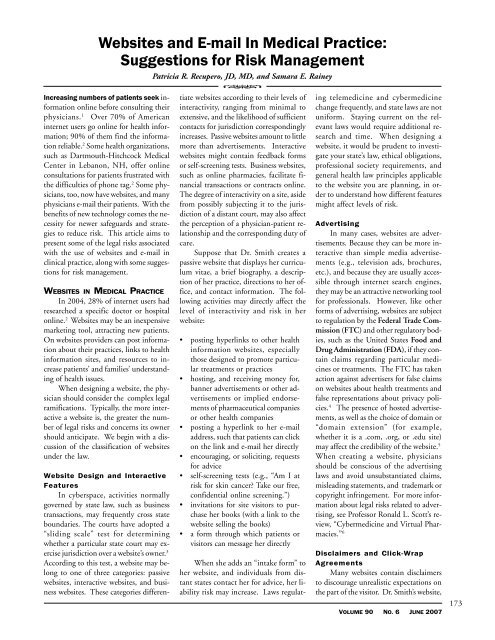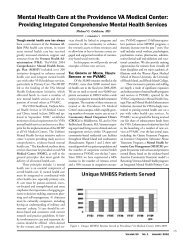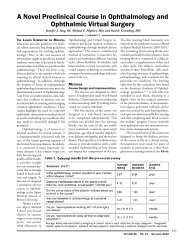June, No.6 - Rhode Island Medical Society
June, No.6 - Rhode Island Medical Society
June, No.6 - Rhode Island Medical Society
Create successful ePaper yourself
Turn your PDF publications into a flip-book with our unique Google optimized e-Paper software.
Websites and E-mail In <strong>Medical</strong> Practice:Suggestions for Risk ManagementIncreasing numbers of patients seek informationonline before consulting theirphysicians. 1 Over 70% of Americaninternet users go online for health information;90% of them find the informationreliable. 2 Some health organizations,such as Dartmouth-Hitchcock <strong>Medical</strong>Center in Lebanon, NH, offer onlineconsultations for patients frustrated withthe difficulties of phone tag. 2 Some physicians,too, now have websites, and manyphysicians e-mail their patients. With thebenefits of new technology comes the necessityfor newer safeguards and strategiesto reduce risk. This article aims topresent some of the legal risks associatedwith the use of websites and e-mail inclinical practice, along with some suggestionsfor risk management.WEBSITES IN MEDICAL PRACTICEIn 2004, 28% of internet users hadresearched a specific doctor or hospitalonline. 2 Websites may be an inexpensivemarketing tool, attracting new patients.On websites providers can post informationabout their practices, links to healthinformation sites, and resources to increasepatients’ and families’ understandingof health issues.When designing a website, the physicianshould consider the complex legalramifications. Typically, the more interactivea website is, the greater the numberof legal risks and concerns its ownershould anticipate. We begin with a discussionof the classification of websitesunder the law.Patricia R. Recupero, JD, MD, and Samara E. RaineyWebsite Design and InteractiveFeaturesIn cyberspace, activities normallygoverned by state law, such as businesstransactions, may frequently cross stateboundaries. The courts have adopted a“sliding scale” test for determiningwhether a particular state court may exercisejurisdiction over a website’s owner. 3According to this test, a website may belongto one of three categories: passivewebsites, interactive websites, and businesswebsites. These categories differentiatewebsites according to their levels ofinteractivity, ranging from minimal toextensive, and the likelihood of sufficientcontacts for jurisdiction correspondinglyincreases. Passive websites amount to littlemore than advertisements. Interactivewebsites might contain feedback formsor self-screening tests. Business websites,such as online pharmacies, facilitate financialtransactions or contracts online.The degree of interactivity on a site, asidefrom possibly subjecting it to the jurisdictionof a distant court, may also affectthe perception of a physician-patient relationshipand the corresponding duty ofcare.Suppose that Dr. Smith creates apassive website that displays her curriculumvitae, a brief biography, a descriptionof her practice, directions to her office,and contact information. The followingactivities may directly affect thelevel of interactivity and risk in herwebsite:• posting hyperlinks to other healthinformation websites, especiallythose designed to promote particulartreatments or practices• hosting, and receiving money for,banner advertisements or other advertisementsor implied endorsementsof pharmaceutical companiesor other health companies• posting a hyperlink to her e-mailaddress, such that patients can clickon the link and e-mail her directly• encouraging, or soliciting, requestsfor advice• self-screening tests (e.g., “Am I atrisk for skin cancer? Take our free,confidential online screening.”)• invitations for site visitors to purchaseher books (with a link to thewebsite selling the books)• a form through which patients orvisitors can message her directlyWhen she adds an “intake form” toher website, and individuals from distantstates contact her for advice, her liabilityrisk may increase. Laws regulatingtelemedicine and cybermedicinechange frequently, and state laws are notuniform. Staying current on the relevantlaws would require additional researchand time. When designing awebsite, it would be prudent to investigateyour state’s law, ethical obligations,professional society requirements, andgeneral health law principles applicableto the website you are planning, in orderto understand how different featuresmight affect levels of risk.AdvertisingIn many cases, websites are advertisements.Because they can be more interactivethan simple media advertisements(e.g., television ads, brochures,etc.), and because they are usually accessiblethrough internet search engines,they may be an attractive networking toolfor professionals. However, like otherforms of advertising, websites are subjectto regulation by the Federal Trade Commission(FTC) and other regulatory bodies,such as the United States Food andDrug Administration (FDA), if they containclaims regarding particular medicinesor treatments. The FTC has takenaction against advertisers for false claimson websites about health treatments andfalse representations about privacy policies.4 The presence of hosted advertisements,as well as the choice of domain or“domain extension” (for example,whether it is a .com, .org, or .edu site)may affect the credibility of the website. 5When creating a website, physiciansshould be conscious of the advertisinglaws and avoid unsubstantiated claims,misleading statements, and trademark orcopyright infringement. For more informationabout legal risks related to advertising,see Professor Ronald L. Scott’s review,“Cybermedicine and Virtual Pharmacies.”6Disclaimers and Click-WrapAgreementsMany websites contain disclaimersto discourage unrealistic expectations onthe part of the visitor. Dr. Smith’s website,VOLUME 90 NO. 6 JUNE 2007173
















